How to Make a Simple Mustard Vinaigrette
One of the first things I learned to make when I learned how to cook or was taught how to cook was a simple vinaigrette. I was in my 20s and didn’t even know how much I would enjoy spending time in the kitchen.
I was dating this wonderful woman who lived in a studio on the Upper East Side of New York City whose kitchen was barely big enough for one, let alone two adults. Yet, it was so tight that just preparing dinner together was enough to create a romantic setting.
Now, in my current kitchen, my wife and I can cook a 5-course meal and not bump into each other once, although I try every chance I get. There’s something to be said for small kitchens. But I digress.
Thinking back, this friend was my first cooking teacher. She taught me how to enjoy good food and how much fun it can be in the kitchen. In addition, she taught me two simple lessons I still preach about on my website: one, use the freshest, best ingredients available, and two, keep it simple.
Although she was an excellent cook, she had a few simple recipes that she could prepare at a moment’s notice, one of which was a mustard vinaigrette.
This vinaigrette is so simple yet delicious; I’ve been serving it to friends and family for the last 20 years and still get rave reviews. Maybe all my friends grew up as I did on those commercial French and Thousand Island dressings brands.
You know, the ones that won’t come out of the jar until you smack them a few times on the bottom, and the next thing you know, you have a big funky glob of dressing on your plate.
Mustard Vinaigrette Basic Ratio
I researched preparing a simple vinaigrette to see how my tried-and-true recipe stood up to the pros. Here are some tips on making a basic vinaigrette, which can be your starting point for many vinaigrettes that can be prepared by altering the ingredients.
Almost all the recipes I found called for a 3-to-1 ratio of oil to vinegar. This ratio is safe to memorize for general knowledge, but it shouldn’t prevent you from creating your own. When making this basic vinaigrette for myself, I rarely measure it out. Instead, I add the ingredients, taste, and adjust.
This isn’t the best way for beginners to learn, but once you get the basic idea of what it should taste like, go for it. If I did measure it out, I would come up with slightly less oil-to-vinegar ratio than 3 to 1.
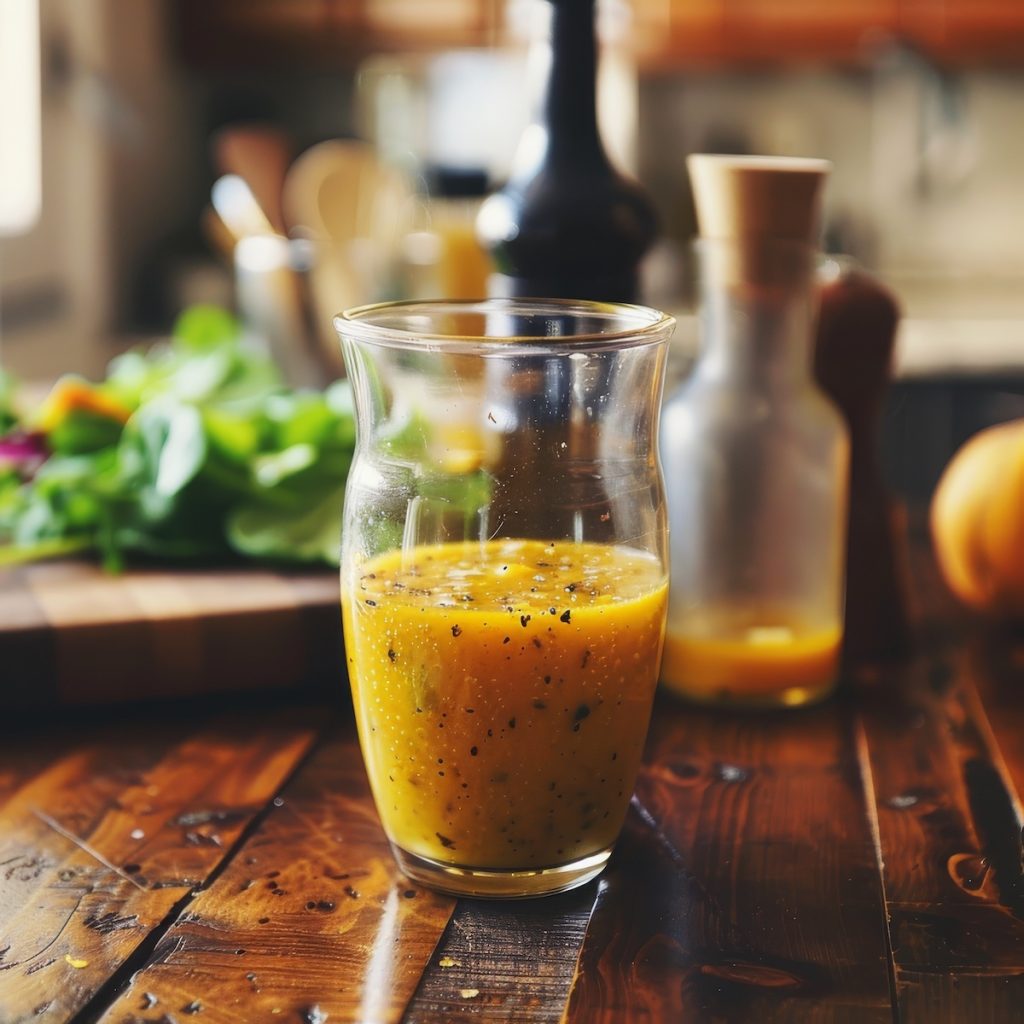
The purest form of vinaigrette is oil, vinegar, and a little salt and pepper mixed right in a bowl of greens. When I was a kid, we used to go to this Italian restaurant; it was more like a pizza joint with tables in the back. They would serve a salad of iceberg lettuce, two slices of cucumber, and a rock-hard wedge of tomato with nothing on it.
On the table would be a cruet of olive oil and a cruet of red wine vinegar. The waiter would come around and ask if I wanted him to dress them. Of course, I wanted him to dress them and toss them, too. He was an expert.
I figured he must have dressed thousands of these salads, so he must know what he was doing. Besides, I had no idea the proper ratio was 3 to 1 at that age.
A slightly more complicated would be to introduce an emulsifier to our vinaigrette. What a horrible-sounding word for something that tastes so good. Why would you add an emulsifier like mustard to your vinaigrette? One reason might be to add an additional layer of flavor.
Another would be to prevent the oil and vinegar from separating. An emulsifier does this. First, combine the vinegar and mustard, season with salt and pepper, and slowly drizzle in the oil while whisking the ingredients together.
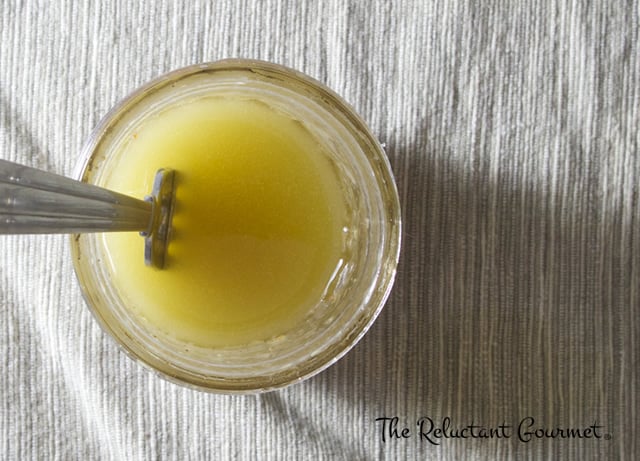
There is no reason to use good olive oil when making a mustard vinaigrette. Why? The mustard overpowers the taste of the olive oil.
So you could use vegetable oil or canola oil. However, you want to use decent French mustard with many flavors.
I typically use Dijon mustard. If you insist on using olive oil, be careful not to overbeat it when combined with the other ingredients so that it does not lose its delicate flavor and become bitter.
Try making a blend of olive oil and some other type of oil. I like to mix my vinaigrette in a used jar with a cover for easy storage. Usually, I save an old mayonnaise or baby food jar.
If the dressing gets low, add more ingredients, taste, and adjust the amounts. Some recipes insist on using a whisk to combine ingredients, although a fork works just fine.
What vinegar you use is your choice and depends on what you are putting the vinaigrette on. I prefer Balsamic vinegar, but you can use red or white, cider, flavored, infused, or even try no vinegar and substitute a citrus juice. (but then it wouldn’t be called a vinaigrette, would it?)
The other ingredients I typically add are garlic, dried parsley, and dried thyme. Some recipes call for chopping the garlic, some for mincing it, and some for pulverizing it with a mortar and pestle. Then, I either smash it with the side of my chef’s knife or use my handy garlic press, which is fun to use but a pain to clean.
I use these essential ingredients, but you should not limit yourself from experimenting with various herbs, spices, and other ingredients. Look in any cookbook or cooking magazine, and you’ll find dozens of variations.
Here’s my basic vinaigrette with measured amounts, but as I said earlier, I usually eyeball it, taste it, and adjust it. If you do this enough times, you’ll be doing the same in no time at all.
Basic Mustard Vinaigrette Recipe
Ingredients
- 1 glove garlic smashed
- 2 tablespoons balsamic vinegar
- 1 teaspoon Dijon mustard
- 6 tablespoons oil vegetable, corn, canola, olive or some combination
- 1 pinch of dried parsley
- 1 pinch of dried thyme
- salt and freshly ground pepper to taste
Instructions
- In a clean jar or small bowl, add the vinegar, garlic, and mustard and mix well.
- Slowly add the olive oil while either whisking or stirring rapidly with your fork.
- Add the parsley, thyme, salt, and pepper, taste, and adjust the seasonings.

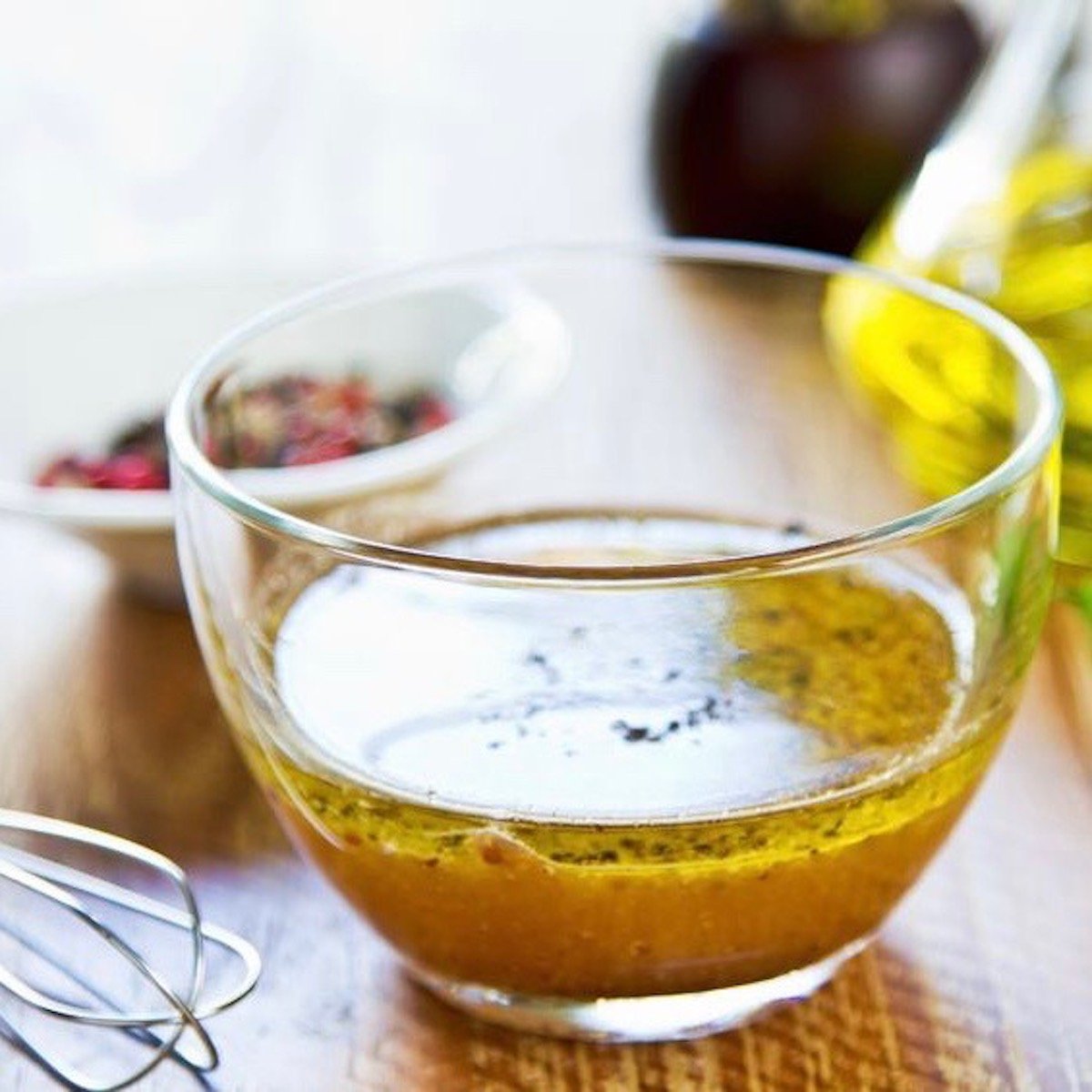
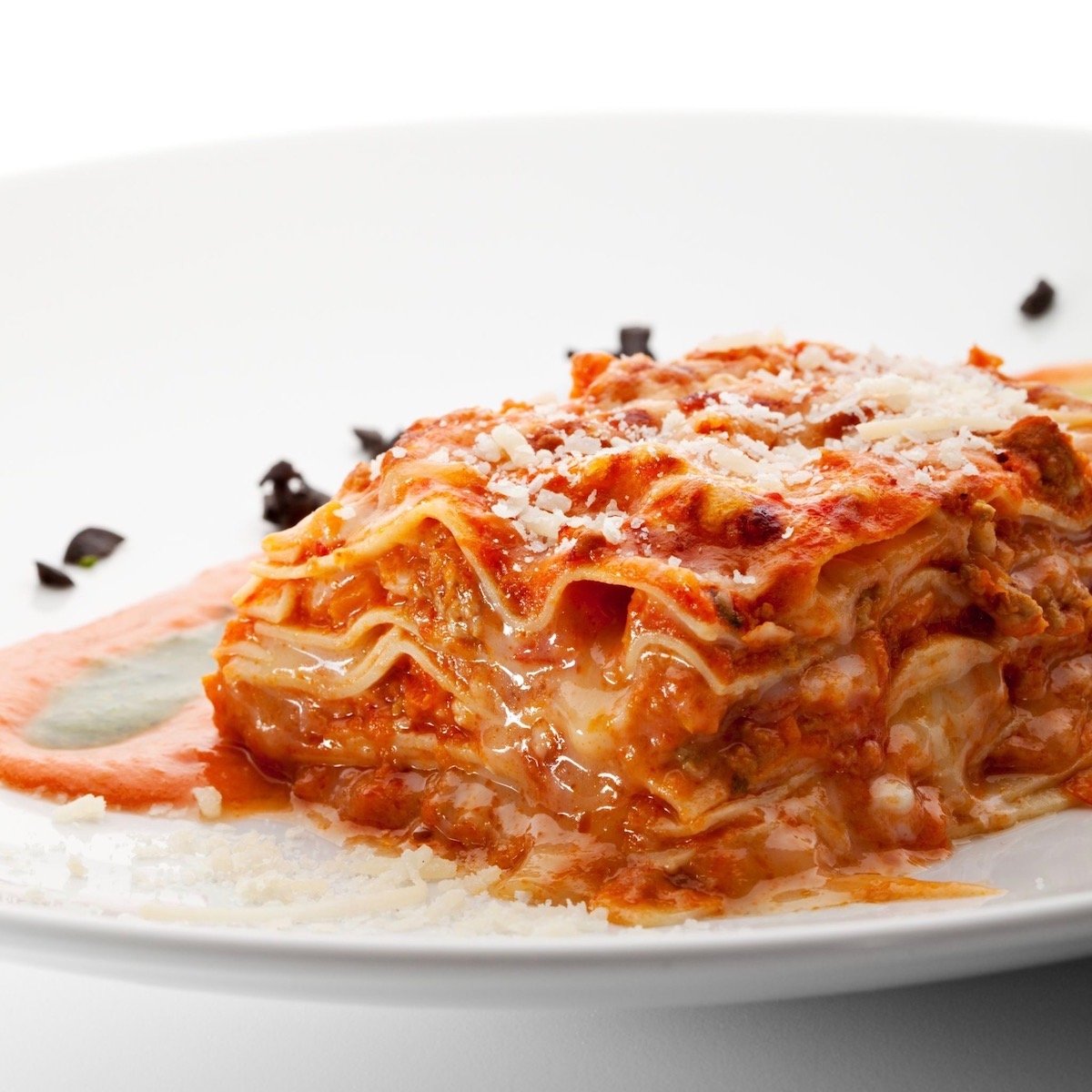
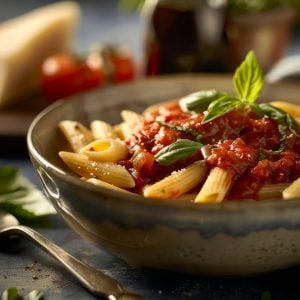




20 Responses
soo….. somehow the picture resembles a mustard vinaigrette. However, adding the balsamic vinegar to the mix completely changes the color. was white wine vinegar the intended ingredient? or is the picture mid production?
Thanks!
Mid production Suzanne – RG
Their is a white balsamic vinegar…
Wonderful and adaptable recipe! I am now empowered and can kiss Kraft goodbye (for the most part).
Thanks for the tip that over beating olive oil makes it bitter! I had no idea…
Mine turned out extremely thick??
How long will this dressing last in the fridge?
Trish, I am not an nutritional expert so I am reluctant to tell you how many days it officially can last in the fridge, but from my own experience, I’ve left it in for a week and it
seems fine. I have commercial salad dressings in my refrigerator that have been in for much longer and they seem fine but who knows what’s in them. I did a quick search for an answer and found this site to offer some useful information, http://cooking.stackexchange.com/questions/15553/how-long-will-homemade-salad-dressing-stay-good-in-the-fridge
Hope this helps some.
Hi, Made one today, and it was so good, my wife really loved it, and she’s picky.
Thanks for the excellent recipe.
And further to add, i grilled asparagus, sandwiched between seasoned fried steak steak (pepper, salt, tyhme and parsly) and on the bottom, pulled pork.
The vinaigrette really complemented it well, and was drizzled generously on the outside, perfect for dipping the asparagus in.
Thank you, it’s wonderful!
How do you mix in the clove of garlic evenly so it creates a mix?
The garlic is smashed so I typically use a fork to combine the garlic and other ingredients. A small whisk works well too or how about putting everything in a jar with a tight lid and give it a shake?
Very LOW carb! I like this recipe. I add a little blue cheese crumbles and a teaspoon of mayo to make a thicker dressing.
Thanks for the recipe! I added honey and creole mustard in place of the dijon, I also used red wine vinegar! So delicious on kale and arugula with grilled salmon!
Helen, great substitution ideas. Thanks for sharing them with me. I love it when other home cooks like myself play around with a recipe to come up with something new and special. Much appreciated. Can’t wait to try your version.
What makes olive oil bitter is using anything less than extra virgin olive oil; not keeping them out of heat and light so that they oxidise (= rancidity); and using Spanish olive oils – which are the cheapest but also notoriously bitter. This doesn’t matter for some dishes, but certainly does for vinaigrette.
Please note that you should always use extra virgin olive oil for health reasons too. Refined and heat extracted olive oils – which is what anything other than extra virgin oil and lesser quality oils (canola etc) and even sunflower oil – are some of the worst things you can eat for your health. On a side note, this is why margarine is so bad for you. Sorry to be the bearer of bad news but I read up on health a lot and have been aware of the oils issue for a long time!
Try adding a dollop or two of lite mayonnaise to recipe. Adds a fullness to the taste of the marinade. Toss marinaded pounded thin chicken breasts on the grille and your guests will be asking “when’s your next bbq?”
Thanks for this tip Lee. Will give it a try.
I also add a teaspoon of honey and teaspoon of bourbon. This the only dressing I use.
Hi Kevin, great additions and I can’t wait to try them especially the teaspoon of bourbon.